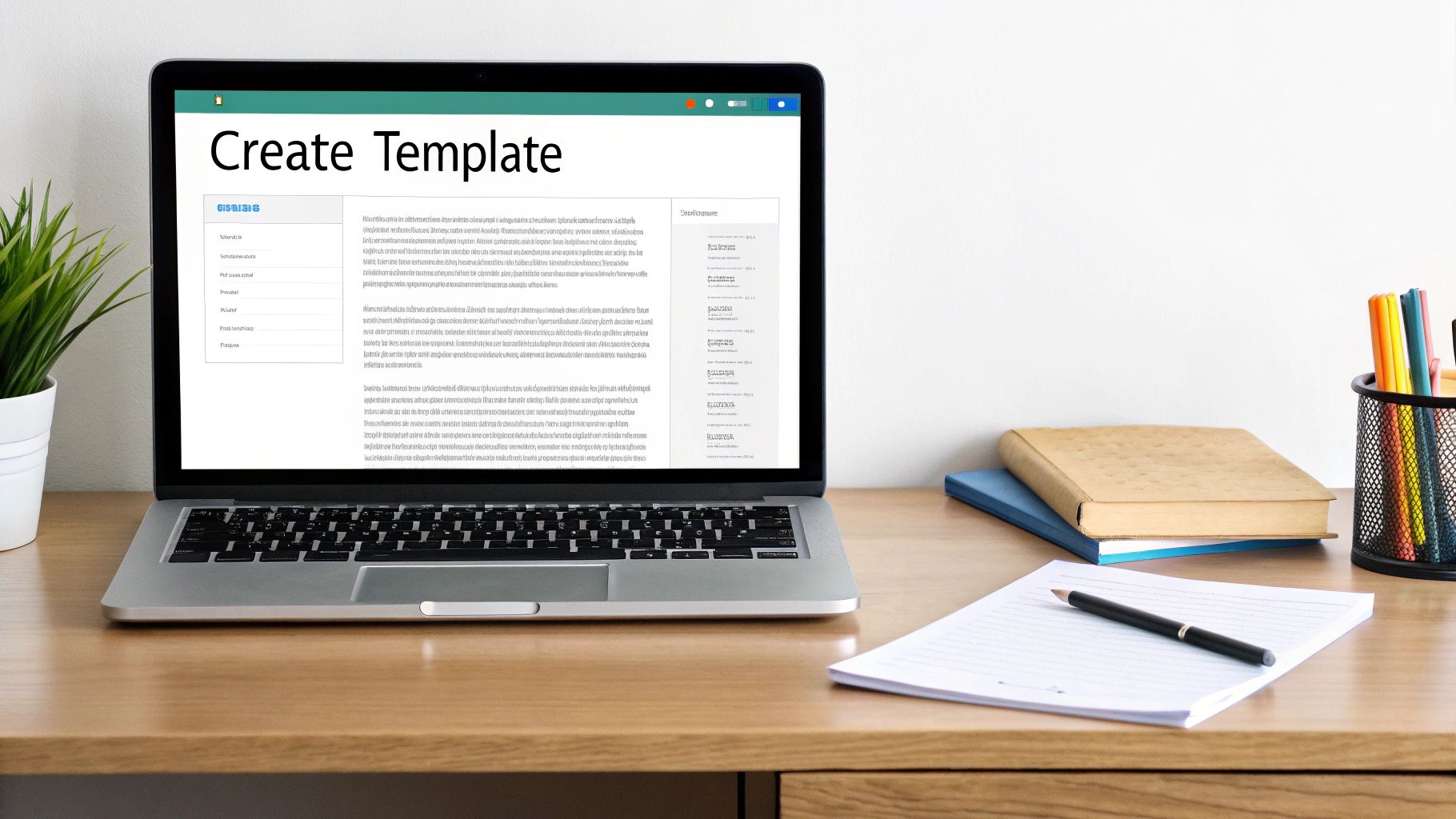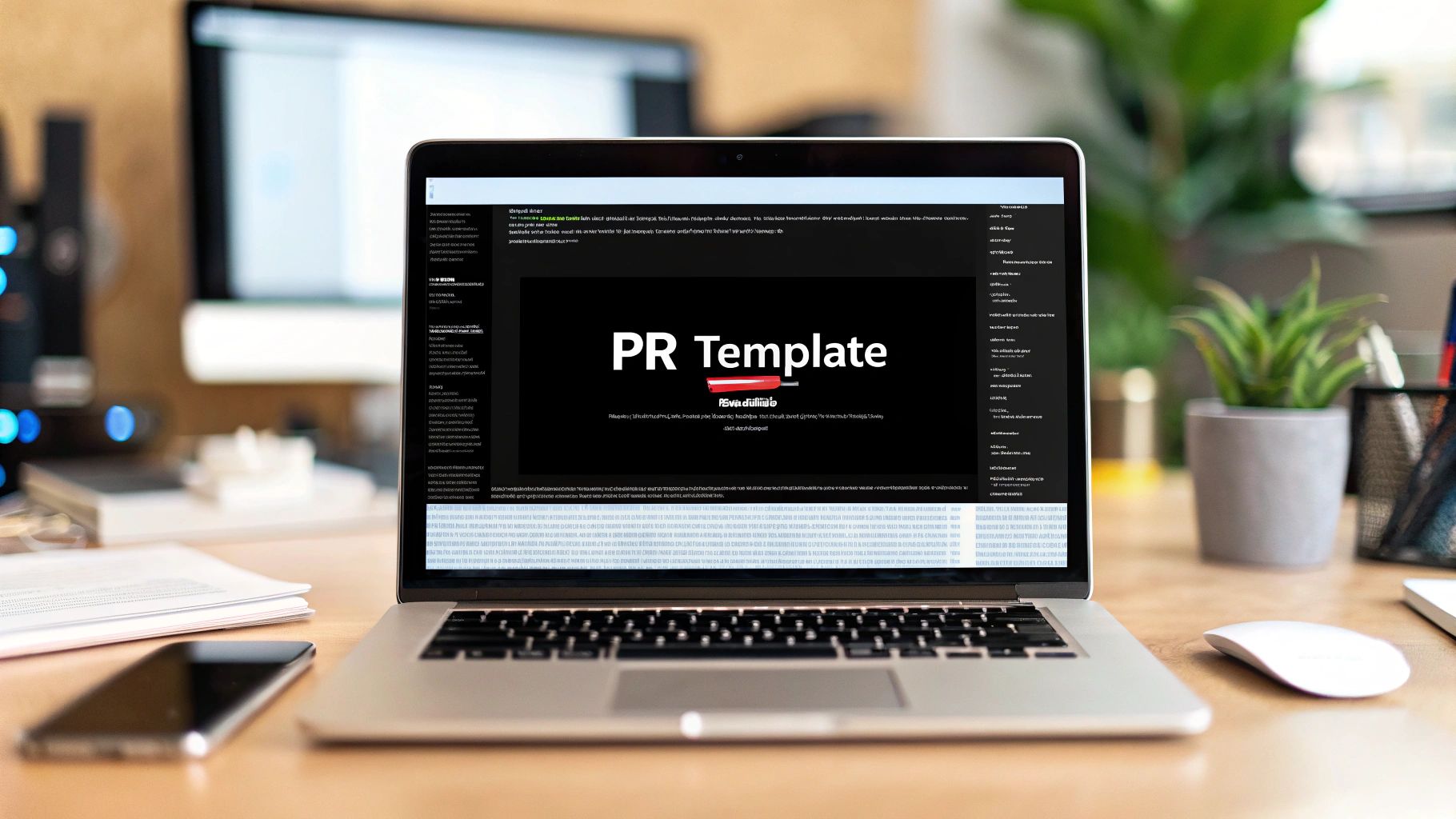pr template github: Streamline Code Reviews
Why PR Templates Transform Development Workflows

Inconsistent pull requests (PRs) can seriously impact a team's productivity and code quality. This lack of structure often creates confusion, lengthens review times, and causes vital information to get lost. Using well-designed PR templates on GitHub can streamline the development workflow and make it far more effective. These templates ensure every PR contains the necessary information.
This structured approach allows reviewers to quickly understand the context, see the changes, and provide more focused feedback.
Standardized PR templates eliminate ambiguity and minimize the constant back-and-forth communication that often slows down code reviews. A good template might include sections for a detailed change description, links to related issues, testing instructions, and screenshots. Having this information readily available eliminates the need for constant clarification.
This makes the review process more efficient, freeing up developers to write high-quality code.
The Impact of Standardized Templates
Using PR templates offers more than just simple efficiency gains. It strengthens engineering culture and improves code quality. With a consistent PR framework, the entire team understands the expectations. This establishes clear quality standards and promotes best practices for code review. A PR template on GitHub helps create a knowledge repository that benefits everyone.
This shared knowledge base grows with every contribution, making onboarding new team members and maintaining consistency across projects easier. Standardized PR templates also lead to measurable improvements in development cycles. For example, they can decrease the median time to first review by up to 30%. More detailed statistics can be found here: Graphite Blog Post.
Scaling Review Processes with Templates
Maintaining consistent code review practices becomes increasingly difficult as development teams grow. PR templates provide a scalable solution. They create a standardized process that new team members can easily adopt and apply across different projects. This consistency is crucial for managing larger codebases and working with distributed teams.
Even as the team expands, the standards remain consistent and effective. By using PR templates, organizations can build a culture of quality and collaboration, resulting in better software and happier developers.
Setting Up Your First PR Template on GitHub

Implementing a Pull Request (PR) template on GitHub is surprisingly simple and can greatly improve your development workflow. This guide provides a step-by-step approach to get you started, regardless of your team's size or project's complexity. We'll explore the technical details, recommend effective file structures, and discuss formatting best practices to encourage widespread template adoption. Understanding GitHub's PR template system ensures your templates are easily discoverable and user-friendly.
Choosing the Right Template Scope
A crucial first step is deciding between repository-specific and organization-wide templates. Repository-specific templates, stored within a project's directory, provide flexibility for tailoring to individual project requirements. On the other hand, organization-wide templates promote consistency across all projects within your organization, reinforcing standardized best practices.
Choosing the best approach involves balancing the need for flexibility with the desire for standardization. A small team focused on a single project might prefer repository-specific templates. A larger organization juggling multiple projects would likely benefit from the broader reach of organization-wide templates. This ensures developers quickly grasp the requirements for any PR, regardless of the specific project.
Implementing Your PR Template
Creating a PR template is as simple as adding a PULL_REQUEST_TEMPLATE.md file in the designated location. For repository-specific templates, place this file in the .github directory at the repository's root, or directly in the root itself. Organization-wide templates follow a similar process; however, the file resides within a specified repository configured in your organization's settings. This difference affects how GitHub presents the template options when initiating a new PR.
GitHub automatically recognizes correctly placed template files. When a contributor creates a pull request, they can select from the available templates via a convenient dropdown menu. This intuitive design promotes consistent template usage.
Understanding Template Locations and Effects
To highlight the implications of different template locations, review the table below:
To better understand where to place your PR template files and the impact of each location, let's look at the following table:
PR Template File Locations and Their Effects: Comparison of different ways to implement PR templates in GitHub repositories
| Location | Scope | Selection Method | Best For |
|---|---|---|---|
| .github/PULL_REQUEST_TEMPLATE.md | Repository | Dropdown in PR creation | Single project, specific needs |
| PULL_REQUEST_TEMPLATE.md (root) | Repository | Dropdown in PR creation | Single project, simplified setup |
| Designated Repository (Organization) | Organization | Dropdown in PR creation | Multiple projects, standardized process |
This table offers a practical guide for making informed decisions about PR template implementation. Understanding these nuances helps you leverage PR templates to streamline your workflow and improve your code review process. Correctly configured PR template GitHub files ensure consistency and efficiency in your team's contributions. Using this, combined with tools like Pull Checklist, empowers you to establish a thorough and effective PR process. Integrating PR template GitHub best practices with automated checklists further elevates code quality and strengthens team collaboration.
Crafting High-Impact PR Template Components

A well-crafted Pull Request (PR) template on GitHub is essential for efficient code reviews. It acts as a guide, ensuring both contributors and reviewers have the information they need. By studying successful open-source projects like React, Kubernetes, and VS Code, we can learn how to design impactful PR templates. This section explores creating templates that balance thoroughness with ease of use.
Essential Components For Effective PR Templates
The primary goal of a PR template is to provide context and clarity upfront. This minimizes back-and-forth communication, streamlining the review process. Each section of the template should serve a specific purpose.
-
Description of Changes: This section gives a summary of the changes. It should clearly explain what has been modified and why.
-
Related Issues: Linking the PR to related issues in the project's issue tracker is important. This helps track progress and provides valuable context.
-
Testing Instructions: Detailed testing instructions are vital for reviewers. These instructions enable reviewers to verify changes effectively and catch potential bugs.
-
Checklist (Optional): A checklist can ensure contributors follow all necessary steps before submitting their PR. This might include code style guidelines, testing procedures, and documentation updates.
To illustrate the practical application of these components, let's look at a table summarizing their purpose and impact.
The following table provides a breakdown of key template sections and their impact on the review process:
| Component | Purpose | Example | Impact on Review |
|---|---|---|---|
| Description of Changes | Summarize the modifications and their rationale | "This PR updates the login form to improve accessibility." | Provides context and understanding of the changes |
| Related Issues | Link PR to relevant issue tracker entries | #123, #456 | Connects PR to broader project goals and bug fixes |
| Testing Instructions | Guide reviewers on how to test the changes | "Run npm test and verify the login form functions correctly in different browsers." | Enables efficient verification and reduces bugs |
| Checklist (Optional) | Ensure contributors follow all necessary steps | - [ ] Code style guidelines followed <br> - [ ] Unit tests added | Improves code quality and consistency |
This table demonstrates how each component contributes to a more effective and efficient review process. By providing clear guidelines and expectations, the PR template helps ensure that all necessary information is readily available.
Balancing Thoroughness and Usability
While detailed information is important, an overly complex PR template can be daunting. The key is to find a balance between comprehensive guidance and a user-friendly experience.
For example, instead of dense paragraphs, use bullet points to describe testing procedures. Visual aids like tables can also improve comprehension. Consider structured options like checkboxes or dropdown menus instead of free-form text fields for certain data. This improves consistency.
Practical Markdown Examples for Real-World Implementation
Markdown is a valuable tool for creating clear and easy-to-use PR templates.
-
Checkboxes:
- [ ] I have tested these changes locally. -
Bold Text:
**Expected Behavior:** Describe the intended outcome of the changes. -
Code Blocks: function example() { // Code example } These simple Markdown elements can significantly improve the usability of your templates. Remember to adapt the template to your project and team. Consider a dedicated repository for PR templates to enhance organization and maintainability. This ensures the template helps rather than hinders the review process.
Supercharging Templates with GitHub Actions

Pull Request (PR) templates on GitHub provide a solid base for consistent and thorough code reviews. However, integrating these templates with the power of GitHub Actions elevates them from static checklists to dynamic workflows. This automation significantly improves the code review process. By automating key parts of your PR workflow, you can maintain high quality standards and simultaneously reduce manual work for contributors and reviewers alike.
Automating Template Completion Validation
One of the most effective ways to use GitHub Actions is to guarantee PR templates are fully completed. Imagine a workflow that automatically verifies all the required fields in your template are filled in before a PR can be merged. This simple check prevents incomplete PRs from slowing down the review process.
For example, you could set up an action to check if the "Description of Changes" and "Testing Instructions" sections have been filled out. This ensures that reviewers have all the necessary information right from the start, reducing back-and-forth communication and unnecessary delays. It also emphasizes the importance of the template itself, encouraging better PR practices.
Routing PRs with Intelligent Automation
GitHub Actions can also smartly route PRs to the appropriate reviewers based on the content of the template. A PR involving database changes, for example, could be automatically routed to the database team. This focused routing system gets the right expertise involved in each review, boosting both the quality and the speed of the review process.
Building Analytical Dashboards with GitHub Actions
Beyond streamlining the review itself, GitHub Actions can collect valuable data about your overall PR process. By integrating with PR analytics tools, you can track key metrics like lead time, contribution volume, and the level of discussion around each PR.
This data-driven approach allows you to pinpoint bottlenecks and make informed decisions about workflow optimization. Tracking the time a PR spends in each stage, for instance, can highlight areas for improvement and lead to greater efficiency. Learn more about how GitHub Actions can be used for analytics: Explore GitHub Actions for PR Analytics. This combination of automated data gathering and analysis empowers teams to continually improve their process.
Real-World Workflow Configurations
Many development teams are already seeing the benefits of combining PR templates and GitHub Actions. This integration creates a solid foundation for code quality that scales effectively as teams grow. From ensuring template completion to providing valuable analytical insights, GitHub Actions maximizes the effectiveness of PR templates and streamlines the entire review process.
Multiple Templates for Different Contribution Types
The power of Pull Request (PR) templates on GitHub isn't a one-size-fits-all approach. Effective teams understand that different contributions need specialized templates for efficient information gathering. A PR for a new feature, for example, needs different information than a bug fix PR. Using multiple PR template GitHub files allows for tailoring the requested information, improving review efficiency. Let’s look at some practical template designs.
Feature Implementations
Feature implementation PRs often have substantial code changes and architectural decisions. Templates should focus on the why and how of the new feature.
- User Story: Explain the value the feature adds.
- Technical Design Decisions: Detailing the technical choices helps reviewers understand the code's deeper logic.
- Performance Considerations: Crucial for performance-sensitive features.
This helps reviewers understand the context and impact of the change.
Bug Fixes
Bug fix templates prioritize clarity and reproducibility. They need information on the bug, steps to reproduce it, the solution, and verification steps. This focused approach streamlines reviews.
- Steps to Reproduce: Clear steps let reviewers recreate the problem.
- Root Cause Analysis: Analyzing the bug's origin helps prevent future issues.
- Verification Steps: Clear testing instructions ensure the fix works.
Documentation Changes
Documentation templates emphasize clarity and consistency. They should include the scope of changes, the rationale, and a review checklist for style and accuracy.
- Summary of Changes: A clear summary simplifies reviews.
- Style Guide Adherence: A checklist ensures consistency.
This maintains documentation quality and findability.
Dependency Updates
Dependency update templates should highlight the changes, the reason for the update (bug fixes, security patches, new features), and any potential impact.
- Reason for Update: Context is key for understanding the change.
- Impact Assessment: Noting potential impacts helps identify early conflicts.
This promotes proactive dependency management.
GitHub's Multiple Template Configuration and Template Versioning
GitHub lets you configure multiple PR templates. Putting template files in the .github/PULL_REQUEST_TEMPLATE/ directory gives contributors a selection menu when creating a PR. Clear template naming conventions are crucial. Consider versioning in your file names (e.g., feature_template_v2.md). This simplifies rollbacks and transitions between template versions. Well-defined templates and clear guidance ensure contributors start right. Regularly review and update templates, incorporating team feedback and adjusting to project needs, to maximize their effectiveness. This dynamic approach to PR template GitHub management helps maintain quality contributions while streamlining reviews. Using Pull Checklist lets you add automated checklists within the pull request for better consistency and time savings by automating routine tasks.
Measuring PR Template Effectiveness With Analytics
After implementing your PR templates, the next crucial step is measuring their effectiveness. This involves more than just anecdotal feedback; it requires a data-driven approach to assess the impact on your development lifecycle. This section explores practical techniques for measuring PR template effectiveness on GitHub using analytics. We'll explore methods for tracking key performance indicators (KPIs) such as review cycle duration, comment volume, revision frequency, and reviewer satisfaction.
Key Metrics for PR Template Evaluation
Tracking the right metrics reveals the true value of using PR templates. Here's a breakdown of crucial KPIs:
-
Review Cycle Duration: This measures the time from PR creation to merge. Shorter durations often indicate improved efficiency.
-
Comment Volume: Analyzing the number of comments per PR can shed light on the clarity of the initial submission. Fewer comments may suggest that templates are providing sufficient context and reducing ambiguity. However, this requires qualitative analysis, as some reduction may reflect decreased reviewer engagement.
-
Revision Frequency: This metric tracks how many times a PR is revised before merging. A decrease in revisions suggests improved initial PR quality due to better information upfront.
-
Reviewer Satisfaction (Qualitative): While harder to quantify, gathering feedback from reviewers about the template's usability and effectiveness is crucial for continuous improvement.
Utilizing Analytics Tools and Methodologies
Several tools can help track these metrics. GitHub's built-in insights provide basic data on PR activity, including merge times. Additionally, integrating PR analytics tools with GitHub Actions allows for more granular data collection and analysis.
For instance, a team could use GitHub Actions to automatically log when a PR moves from draft to review, offering detailed insights into potential bottlenecks. The increasing use of these tools has yielded positive results, providing teams with valuable performance insights. Explore this topic further: Discover more insights about PR analytics tools.
Visualizing Data for Actionable Insights
Raw data is only useful when it's easily understood. Visualizing data through charts and graphs transforms complex information into actionable insights. For example, plotting the average review cycle duration over time can visually demonstrate the impact of PR template implementation or modifications.
Similarly, visualizing comment volume can uncover trends related to PR template usage. Tools like PullPanda offer features like leaderboards, allowing for the quick and easy identification of top contributors, which can be useful for performance reviews.
Case Studies and Real-World Examples
Examining real-world case studies further emphasizes the value of data-driven PR template refinement. By analyzing how other teams have utilized analytics to improve their processes, you can gain valuable practical insights.
For example, a team might find that their template's testing instructions section consistently generates many comments. This insight prompts them to revise the section, providing more specific guidance on testing procedures, which, in turn, leads to a decrease in comment volume and faster review cycles.
Continuous Improvement and Template Evolution
Measuring PR template effectiveness isn't a one-time activity; it's a continuous process. Regularly reviewing the collected data, gathering feedback from reviewers, and iterating on template design are crucial for ongoing improvement. This ongoing refinement ensures that templates remain relevant, effective, and tailored to your team's specific needs.
Using Pull Checklist, you can further enhance your PR process by adding automated checklists directly within the pull request, ensuring key steps are never missed. This integration strengthens consistency and streamlines code reviews even further.
Template Strategies From Industry-Leading Projects
What can we learn from organizations that have successfully implemented PR templates on GitHub? This section explores template implementations from well-regarded open-source projects, offering valuable insights applicable to any development team. By examining these real-world examples, we can identify practical approaches to common code review challenges and optimize our workflows.
Learning From React, TensorFlow, and VS Code
Projects like React, TensorFlow, and VS Code handle thousands of contributions. Their PR templates are vital for maintaining code quality and consistency. These templates often include specialized sections tailored to the specific needs of each project.
-
React: Emphasizes clear explanations of code changes and their impact on the user experience. Visual aids, like before-and-after screenshots, are often included to help reviewers quickly understand the changes. This practice helps maintain a high standard of UI consistency.
-
TensorFlow: Prioritizes detailed testing instructions and performance benchmarks. Given the complexities of machine learning, these template sections ensure that code changes are thoroughly vetted for performance and accuracy before integration.
-
VS Code: Often includes specific sections for accessibility considerations, highlighting the project's commitment to inclusivity. This ensures all contributions adhere to accessibility best practices.
These examples demonstrate how PR templates can be customized to reflect a project's unique needs and values.
Balancing Review Standards With Contributor Experience
Effective templates strike a balance between maintaining thorough review standards and creating a positive contributor experience. An overly complex template can deter contributions, while an overly simplistic one might fail to collect the necessary information. Successful projects achieve this balance by using clear, concise language, structured sections, and helpful examples within their templates. They also often include guidance on how to complete each section, simplifying the process for new contributors.
Adapting Templates to Specialized Workflows
Leading projects often tailor their PR templates to specific types of contributions. For instance, different templates might be used for bug fixes, feature implementations, and documentation updates. This targeted approach ensures the requested information is relevant to the specific task, thereby streamlining the review process. This ultimately improves efficiency for everyone involved.
Evolution and Community Feedback
PR templates are not static documents. Leading projects actively solicit feedback from their communities and regularly iterate on their templates based on that feedback. This iterative approach ensures the templates remain effective and adapt to the evolving needs of the project and its contributors. This commitment to continuous improvement optimizes the entire development lifecycle.
By analyzing the strategies of these successful projects, we can glean invaluable insights into creating impactful PR templates. Adapting these lessons to your own workflows can significantly improve the quality and efficiency of your code reviews.
Ready to boost your code review process? Pull Checklist is a useful GitHub Marketplace app that automates and streamlines code reviews with condition-based checklists, ensuring thoroughness and consistency across all your pull requests. Try it today and see the difference: Pull Checklist
